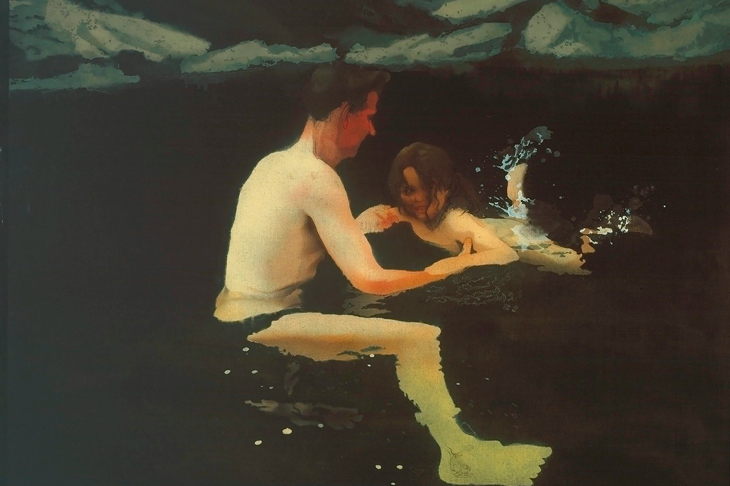In the mid-1940s, Frank Auerbach remarked, the arbiters of taste had decided what was going to happen in British art: Graham Sutherland was going to be the leading painter. ‘Then downstage left, picking his nose, Francis Bacon sauntered on. And the whole scene was changed.’ But how did it alter? What happened to figurative painting in London in the decades after Bacon exploded on to the scene? This is a question with which All Too Human at Tate Britain grapples.
It is an old problem. When in 1976 R.B. Kitaj proposed that there was an important group of figurative artists at work here, a ‘School of London’, he defined them as ‘a herd of loners’. Some, but not all, drank together and socially — at least until they fell out, which often occurred spectacularly if Bacon was at one of the parties. But artistically, for the most part, they were sui generis.
Consequently, the exhibition is full of odd couples and incompatible pairings. One half of a gallery is hung with pictures by Michael Andrews and the other with works by Kitaj himself. These are two idiosyncratic figures, both of whom are, in hall-of-fame terms, pending.
Kitaj’s reputation plummeted after a misconceived retrospective in 1994, and the disproportionately violent critical response that followed. Michael Andrews, in contrast to the abrasive and articulate Kitaj, tended to fly beneath the radar when he was alive, and was accorded a fine posthumous exhibition at Tate to which unfortunately almost nobody came. Only now is the idea dawning that he might have been a truly important figure. And so might Kitaj, after all.
It must have been tempting to put Andrews and Kitaj together. A text on the wall points out, correctly, that they both owed something to Bacon. But in practice, Kitaj’s tendency to bright, slightly bilious colour and jangling compositions fights with Andrews’s elusiveness and subtlety.
Even when painters have a real affinity their works may not help each other. William Coldstream was a highly influential teacher of, among others, Euan Uglow, whose works are hung beside his. But this juxtaposition obscures the individuality of Uglow, who evolved into an extraordinary amalgam of Coldstream, Piero della Francesca and the White Knight from Alice (his models would pose, often very uncomfortably, amid plumb lines and contraptions of his own devising, designed to aid precise observation of their bodies).
Still, there is a strong connection between Coldstream and Uglow. But putting the young Lucian Freud in the same room with them is just misleading. It is true that Bacon, after he and Freud had quarrelled, delighted in describing the latter’s work as ‘the very epitome of the Euston Road School’ — that being the label given to Coldstream and his followers (Bacon meant this as an insult). But though Freud also worked from close observation of a model, he was interested in matters such as their mortality, the impact of their presence and what was ‘going on in their heads’, which didn’t concern Coldstream and Uglow at all.
Nor did Freud have much to do with Bacon aesthetically, close friends though they were for 25 years. Freud invariably worked ‘from life’ — in front of the subject; Bacon virtually never. Bacon habitually used photographs, Freud hardly at all. And neither is there much connection with Francis Newton Souza, an Indian painter who moved to London in 1949, who gets a room to himself (though some strained links are suggested). Souza’s work looks closer to Parisian art brut than anything else done in London.
The most convincing pairing is Auerbach and Leon Kossoff, but even then only in their earliest years. After a while quite distinct painterly personalities emerged. This is perhaps why the subtitle of the show — ‘a century of painting life’ — is so vague. ‘Painting life’ could mean anything.
Although the exhibition contains many magnificent pictures, and draws attention to some unjustly neglected figures, ill-assortment runs through it like a leitmotif. It begins, reasonably enough, with Bomberg and Sickert — who really did have an effect on what came later in London – but also unexpectedly throws in the Russian-French-Jewish Soutine. It is good to see a group of younger painters in the last room — Jenny Saville, Celia Paul, Cecily Brown and Lynette Yiadom-Boakye — as a sort of coda. But you can’t help noticing how different they are.
Of course, the arbiters of what is happening in art, including Tate curators, often get it wrong. The final verdict on many of the artists in All Too Human — Kitaj, Uglow and Andrews among them — is not yet in. Bacon liked to point out that time is the only great critic, which lets the rest of us off the hook — at least a bit.






Comments